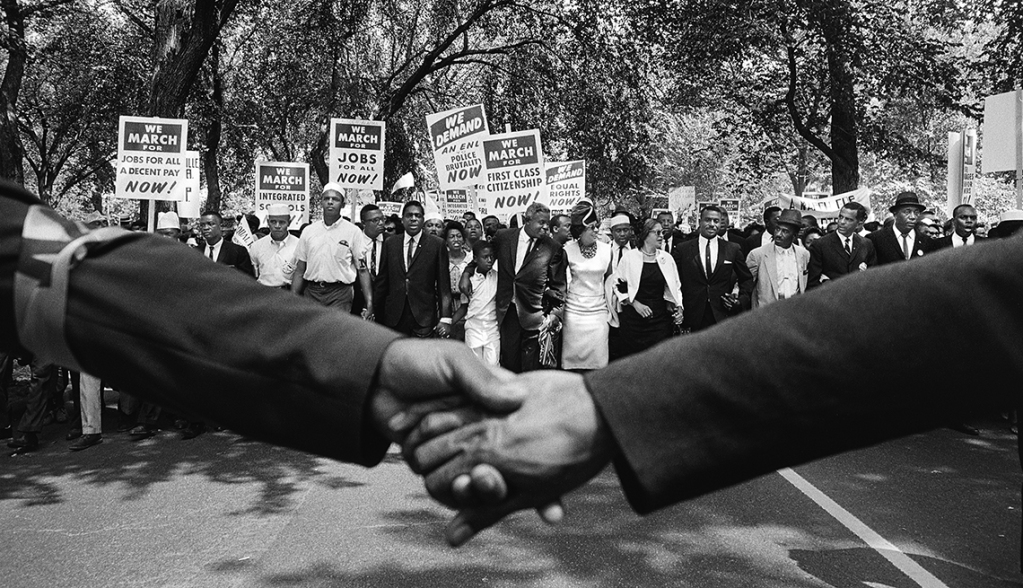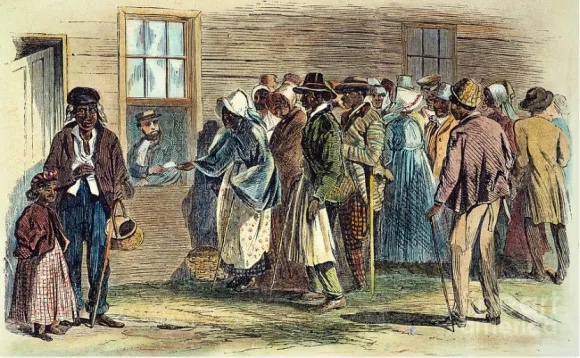The very basis of American freedom, opportunity and the American dream, is that if you work hard, you should receive the fruit of your labor. This promise ‘for all men’ was violently interrupted, and intentionally blocked by those who landed in Jamestown, Virginia in 1619, and who later took up roots throughout the American south for the more than 250 years that followed. This was the slave period in America.
Today, African Americans represent the only group of people — American citizens to be exact— to ever be enslaved on American soil. And beyond the utter inhumanity and indignity of the institution of slavery itself, the result was a denial of pay for time worked (wages), along with the absolute inability to convert wages into capital for investments (it is a fact that we could not amass capital, precisely because we were capital; bought, sold, traded, insured, etc.).
Additionally, the continuing cost of the legacy of racism and bias in society has become like a tax levy, or limitation on our true growth and prosperity as a nation. A recent Citi Report showed that the economic impact of just 20 short years of racism against African-Americans resulted in a $16 trillion loss in GDP (Gross Domestic Product). And more so, if these practiceswere ended in real time, national GDP would add $1 trillion annually for the next 5 years.
Countless reports have now shown that diversity and inclusion drive the best economicoutcomes for cities, companies and communities alike.
Looking back over America’s 250-year legacy of slavery alone, it could be easily argued that the slavery of African-Americans was the largest single reverse transfer of wealth in America’s history. In 1840, slaves were twice as valuable than the railroad system, which was thought to be the most valuable asset in America at that time. The wealthiest city in the world per capita in 1840, was Natchez, Mississippi, a riverfront city which specialized in the slave trade and theexport of cotton.
Later on, in our shared American story, there were efforts to restore basic humanity and humandignities to the African-American experience, but in each of these two cases, legitimate efforts by the nation’s leaders to transform the ‘groundwater’ effects of institutional racism and bias were thwarted and upended.
The First Reconstruction of 1865-1872.
The 1st Reconstruction Period in America followed the conclusion of the Civil War and the end of slavery in 1865, and addressed issues of fundamental freedoms. The centerpiece of the 1st Reconstruction was the Freedman’s Bureau, which was chartered to provide practical aide to the 4 million African-Americans in their transition from enslaved to free. The Freedman’s Bureau resulted in the creation of schools, hospitals and other infrastructure to assist the Blackpopulation of that day.
The Freedman’s Bureau also created the Freedman’s Bank, on March 3, 1865, which was chartered to ‘teach freed slaves about money.’ This was in effect the plan to provide the Blackrace with their necessary financial literacy education as they began their freedom journey in a free enterprise America. With the assassination of President Lincoln, and despite the efforts ofthe great Frederick Douglass to save it (investing $10,000 of his own funds in the process), thebank was subsequently mismanaged and undermined and failed in 1874.
With $52 million in deposits and more than 73,000 former slaves losing almost all of their savings, it is understandable why many Black Americans today are hesitant to ‘trust’ traditionalbanks and the American banking system. After all, the Freedman’s Bank ‘was’ the government’s bank, and even it failed them.
This period was designed to move the formerly enslaved African- American population from theslave plantations to their own fields of planting and agriculture.
The Compromise of 1876, which pulled federal troops out of the southern states and ended federal intervention in the affairs of the south, effectively ended Reconstruction as we knew it.
The Second Reconstruction of 1958-1968.
This period, highlighted by the emergence of the Civil Rights Movement, was designed to move African-Americans from basic civil rights and civil liberties straight into the mainstream ofall-American life, including fair and equal access to public facilities, obtaining mainstream jobs,and later for many the attainment of true middle-class status, made possible through the higher education of a generation.

This period’s struggle for true freedom in America moved Blacks from hiding themselves in theshadows of society, to respectfully protesting for their rights in the streets of America’s biggestcities. The signature voice of this period was none other than Dr. Martin Luther King, Jr., who roused the nation’s soul with his ‘I Have A Dream Speech’ in Washington, DC.
The results of this period included a growing inclusion of Blacks in the workforce, and the mostsignificant increase of Blacks in all levels of government, from local to state to federal government posts. Unfortunately, this period effectively ended with the assassination in 1968 of both Dr. King and former U.S. Attorney General Robert F. Kennedy. Following this, the air inthe balloon of hope seem to disappear.
The Third Reconstruction of 2020-2030.
Over the course of a six-month period in America, America’s prosperity- for-all story was disrupted by 1) a global health pandemic that rivals the Spanish Flu, and is still raging, 2) a 400-year old social justice reckoning of Black America, 3) an economic crisis of unemployment that rivals the Great Depression, and 4) a crisis of our core democracy itself, resulting in a violent attack of our Capitol on January 6, 2021.
And as a direct result of the COVID19 crisis, the vast majority of Americans were at home watching television news, when they witnessed the first public lynching of our generation: the8-minute murder of George Floyd. More than 6 months later, this same group was sitting at home watching television as they witnessed the first assault on our US Capitol Building sincethe insurrection of 1812, but that time it was British troops that attacked us. This time, it wasus against us. A much more dangerous threat to our democracy.
Operation HOPE believes that the 10-year period from the tumultuous 2020, through 2030 represents what it and others have referred to as the 3rd Reconstruction period. This is our time, as one nation, to reset everything and to re-imagine fair-play and justice in America again.
Operation HOPE believes that America is at war, both with foreign economic interests abroad, who want to replace America as the sole superpower in the world today, and a culturalwar with fellow Americans right here at home, who have lost too much hope, faith, and belief in America’s shared aspirational dream, and in each other. The first war we should win, and the second one we must.
Operation HOPE believes that America is not so much a country as an idea, and, in this era,we must re-imagine her with a software upgrade of both cultural and competitive greatness.
We believe that even a society as fractured as we appear to be today, individuals who are separated by black and white, red and blue, urban and rural, even those religious and agnostic,can find agreement and common cause in the color green. The color of U.S. currency.
We believe strongly that the primary issues driving division and challenges today are more so along the lines class and poverty, than simply an issue of race and the color line. That whethersomeone is white, black, red, brown or yellow, everyone wants to see some more green (representative of economic progress and prosperity in America, which also speaks to class distinctions).
At Operation HOPE we see a large measure of social justice being achieved through an economic lens. And more so, that society can achieve a substantial measure of social justicethrough financial inclusion, economic empowerment, and opportunity for all.
In this regard, the American private sector, where nearly 90% of all jobs come from, and substantially all legitimate wealth is created, will once again play an important role in what happens next in America (the private sector was also principally responsible for integrating the American South during the Civil Rights Movement of the 1960s, as it was business that first took down the ‘whites only’ signs and granted universal access, not the government).
The New Marshall Plan was written with an emphasis on the federal government as a lead actor, focused on national public policy initiatives that could have outsized impact and helpreset a nation in need of a war plan.
The Third Reconstruction Plan was written with the private sector in mind, and focuses itsenergies on the impact that leadership initiatives lasting a decade could have on a reset America with aspiration and opportunity filling every corner of society.
Taken together, The New Marshall Plan and The Third Reconstruction Plan represent our respectful attempt at a comprehensive business plan for the nation. One that gets us not onlyback to work, but builds us back better, stronger, more resilient, and hooked on shared and sustainable economic growth plan that lifts all boats in America.
How we are taking action. A 3-point,10-year plan.
- (Financial & Investor Education) Financial Literacy for All:
An initiative led by WalmartCEO Doug McMillon and Operation HOPE Founder John Hope Bryant to rally corporate leadership in broad-based support of financial literacy, to make financial literacy the civil rights issue of this generation, and to make financial literacy the law of the land and as basic. This also includes a national financial coaching program for the vast majority of allAmericans.
-
(Business & Entrepreneurship) 1 Million New Black Businesses:
A 10-year partnershipled by Shopify President Harley Finkelstein and Operation HOPE Founder John Hope Bryant, and backed by a $130M commitment from Shopify, to stand up 1 million new Black-owned small businesses and new Black entrepreneurs in America over a 10-year period. -
(Jobs & Careers) The Corporate Inclusion Project:
Led by corporate leaders and Operation HOPE, this initiative is about repairing the aspirational ladder of and for jobs, career and corporate opportunity within corporate America, and will focus on increasing levels of minority internships, apprenticeships, corporate positions and seats on companyboards of directors.
This last and hopefully final period of Reconstruction, which we refer to as the Third Reconstruction, is designed to move Blacks from simply protesting in the streets, to true economic access, opportunity and empowerment in America’s corporate C-Suites. To expandfree enterprise and capitalism so that it involves all of God’s children, in a vision of and for aspirational opportunity for all.

